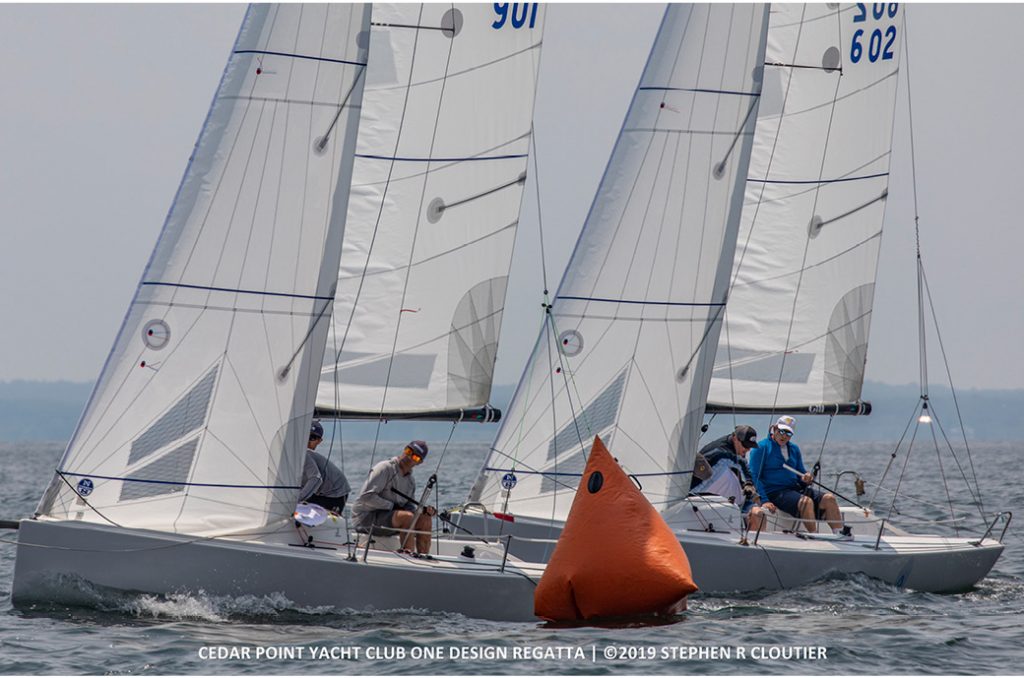There are few places on the racecourse where the ability to turn your boat efficiently is more critical than when you are bearing off around the windward mark. Of course, from a safety standpoint, ducking another boat in lots of breeze is probably number one. But if you want top performance, you must be able to steer smoothly and quickly around the first mark.
When you bear off onto a reach or run, you must employ all the basic boathandling skills that you use for any other turn on the racecourse. It’s OK to use your rudder to help make the turn, but over-reliance on this method slows you down and may not even work (have you ever tried to bear off on a windy day using only the rudder?). Instead, use two other methods of turning as much as possible.
Turn by adjusting sail trim
When you want to turn your boat quickly and efficiently, you have to use your sails in conjunction with your rudder. The way your sails are trimmed has a large effect on where the boat wants to go. For example, if the mainsail is trimmed tightly it pushes your stern to leeward and makes the bow head up toward the wind. If the mainsail is eased, it allows the boat to bear off. This is what you want as you round the windward mark.
Using your sails to turn the boat is especially effective (and necessary) when it’s windy. If you don’t ease your mainsheet as you reach the windward mark, the boat will heel over and the rudder will load up with windward helm, making it very difficult to bear off. To avoid this, ease the sheet out far enough to keep your helm nearly neutral. In windy conditions you may have to dump the mainsail all the way out until it’s luffing. Your goal is to make it easy to bear off without fighting the rudder. This will reduce rudder drag and help you keep going fast.

As you get closer to the windward mark, you often encounter lots of boats and close tactical maneuvers. It’s easy to get caught up in traffic and lose many places. If you want to round the mark in good shape, keep your head out of the boat. © Stephen R Cloutier
Turn using crew weight
Another way to help turn your boat with less rudder drag is by using crew weight to change your angle of heel. If you want the boat to turn to port, heel to starboard. If you want it to turn to starboard, heel to port. Moving your weight works best in light air when there is not so much pressure in the sails. In these conditions, you can still control most boats with your weight, and sail trim will have less effect on turning.
When you want to bear off around the windward mark, heel the boat to windward (to starboard for a port rounding). Even if you don’t have enough weight to actually heel the boat to windward, try to reduce leeward heel as much as possible. This (in combination with easing the main) will keep the boat flatter and reduce rudder drag.
In most conditions, you should hike hard to windward as you bear off around the mark. A common mistake is for crews to move in off the windward rail as soon as their bow reaches the mark. But this allows the boat to heel and makes it much harder to bear off. So keep your crew hiking fully until you have borne away; then they can move inboard to set the chute.
More thoughts on turning
Though sailors almost always use their rudder (at least a little) to help them bear off around the windward mark, you should really think of it as a last resort. Use sail trim and crew weight as much as possible instead, and you will keep the boat going fast onto the second leg.
Your rudder may actually be helpful in certain situations when you are going slowly near the mark. Though you are never allowed to scull (move the helm back and forth across centerline to propel your boat forward), you can move the rudder forcefully to either side for the sole purpose of turning the boat. If you’ve lost steerage, for example, this might be the only way to bear off around the mark. ■
This article originally appeared in David Dellenbaugh’s Speed & Smarts, The newsletter of how-to tips for racing sailors. If you want to sail faster and smarter, log onto SpeedandSmarts.com.
A resident of Easton, CT, Dellenbaugh was tactician and starting helmsman for America3’s successful defense of the America’s Cup in 1992. He’s a Lightning World Champion, two-time Congressional Cup winner, seven-time Thistle National Champion, two-time winner of the Canada’s Cup, three-time Prince of Wales U.S. Match Racing Champion, and a winner of the U.S. Team Racing Championships for the Hinman Trophy.



